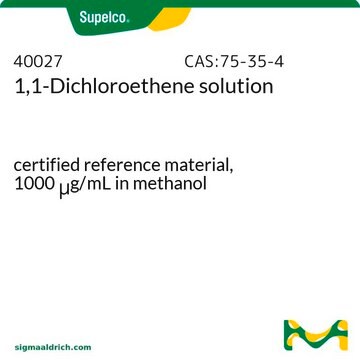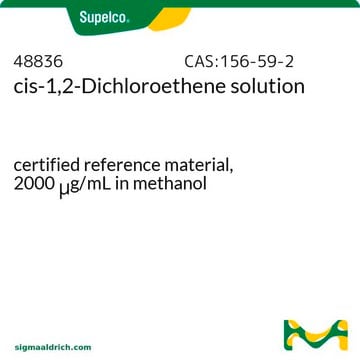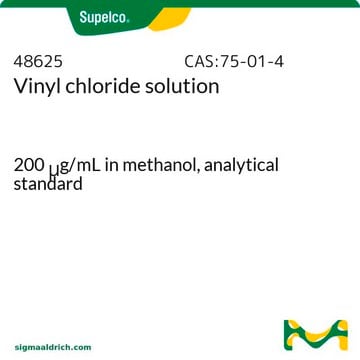163023
1,1-Dichloroethylene
contains 200 ppm MEHQ as inhibitor, 99%
Sinonimo/i:
Vinylidene chloride
About This Item
Prodotti consigliati
Densità del vapore
3.46 (vs air)
Tensione di vapore
9.68 psi ( 20 °C)
Saggio
99%
Forma fisica
liquid
Temp. autoaccensione
968 °F
contiene
200 ppm MEHQ as inhibitor
Limite di esplosione
15.5 %
P. eboll.
30-32 °C (lit.)
Punto di fusione
−122 °C (lit.)
Densità
1.213 g/mL at 20 °C (lit.)
Temperatura di conservazione
2-8°C
Stringa SMILE
ClC(Cl)=C
InChI
1S/C2H2Cl2/c1-2(3)4/h1H2
LGXVIGDEPROXKC-UHFFFAOYSA-N
Cerchi prodotti simili? Visita Guida al confronto tra prodotti
Applicazioni
Avvertenze
Danger
Indicazioni di pericolo
Classi di pericolo
Acute Tox. 3 Oral - Acute Tox. 4 Inhalation - Carc. 2 - Eye Irrit. 2 - Flam. Liq. 1 - Skin Irrit. 2
Codice della classe di stoccaggio
3 - Flammable liquids
Classe di pericolosità dell'acqua (WGK)
WGK 3
Punto d’infiammabilità (°F)
-2.2 °F
Punto d’infiammabilità (°C)
-19 °C
Dispositivi di protezione individuale
Eyeshields, Faceshields, Gloves
Certificati d'analisi (COA)
Cerca il Certificati d'analisi (COA) digitando il numero di lotto/batch corrispondente. I numeri di lotto o di batch sono stampati sull'etichetta dei prodotti dopo la parola ‘Lotto’ o ‘Batch’.
Possiedi già questo prodotto?
I documenti relativi ai prodotti acquistati recentemente sono disponibili nell’Archivio dei documenti.
I clienti hanno visto anche
Il team dei nostri ricercatori vanta grande esperienza in tutte le aree della ricerca quali Life Science, scienza dei materiali, sintesi chimica, cromatografia, discipline analitiche, ecc..
Contatta l'Assistenza Tecnica.












